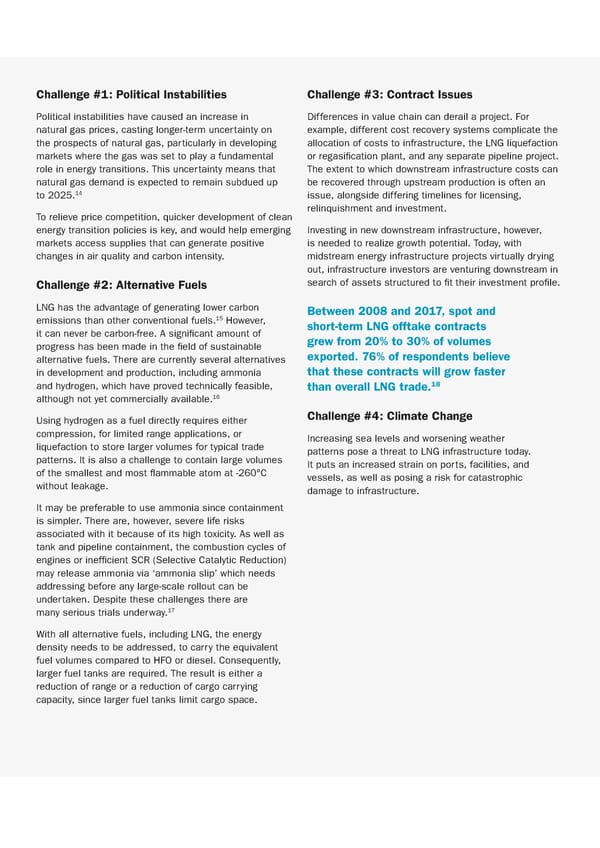Challenge #1: Political Instabilities Challenge #3: Contract Issues Political instabilities have caused an increase in Differences in value chain can derail a project. For natural gas prices, casting longer-term uncertainty on example, different cost recovery systems complicate the the prospects of natural gas, particularly in developing allocation of costs to infrastructure, the LNG liquefaction markets where the gas was set to play a fundamental or regasification plant, and any separate pipeline project. role in energy transitions. This uncertainty means that The extent to which downstream infrastructure costs can natural gas demand is expected to remain subdued up be recovered through upstream production is often an 14 to 2025. issue, alongside differing timelines for licensing, To relieve price competition, quicker development of clean relinquishment and investment. energy transition policies is key, and would help emerging Investing in new downstream infrastructure, however, markets access supplies that can generate positive is needed to realize growth potential. Today, with changes in air quality and carbon intensity. midstream energy infrastructure projects virtually drying out, infrastructure investors are venturing downstream in Challenge #2: Alternative Fuels search of assets structured to fit their investment profile. LNG has the advantage of generating lower carbon Between 2008 and 2017, spot and 15 emissions than other conventional fuels. However, short-term LNG offtake contracts it can never be carbon-free. A significant amount of grew from 20% to 30% of volumes progress has been made in the field of sustainable exported. 76% of respondents believe alternative fuels. There are currently several alternatives in development and production, including ammonia that these contracts will grow faster and hydrogen, which have proved technically feasible, than overall LNG trade.18 16 although not yet commercially available. Using hydrogen as a fuel directly requires either Challenge #4: Climate Change compression, for limited range applications, or Increasing sea levels and worsening weather liquefaction to store larger volumes for typical trade patterns pose a threat to LNG infrastructure today. patterns. It is also a challenge to contain large volumes It puts an increased strain on ports, facilities, and of the smallest and most flammable atom at -260°C vessels, as well as posing a risk for catastrophic without leakage. damage to infrastructure. It may be preferable to use ammonia since containment is simpler. There are, however, severe life risks associated with it because of its high toxicity. As well as tank and pipeline containment, the combustion cycles of engines or inefficient SCR (Selective Catalytic Reduction) may release ammonia via ‘ammonia slip’ which needs addressing before any large-scale rollout can be undertaken. Despite these challenges there are 17 many serious trials underway. With all alternative fuels, including LNG, the energy density needs to be addressed, to carry the equivalent fuel volumes compared to HFO or diesel. Consequently, larger fuel tanks are required. The result is either a reduction of range or a reduction of cargo carrying capacity, since larger fuel tanks limit cargo space.
 TM&I LNG Flexibility Factor Report Page 7 Page 9
TM&I LNG Flexibility Factor Report Page 7 Page 9